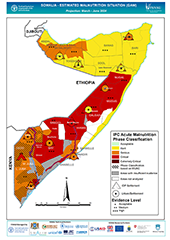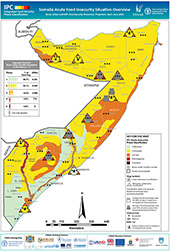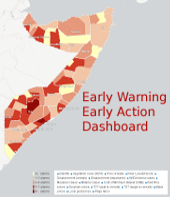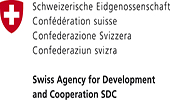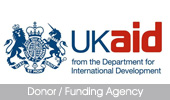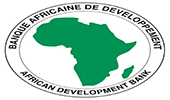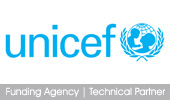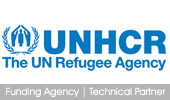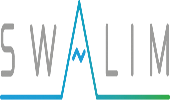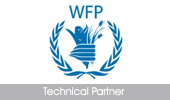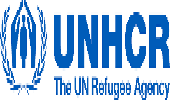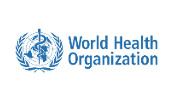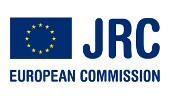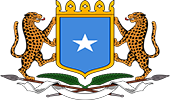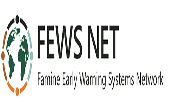SOMALIA Food Security Alert
Issued: May 9, 2017
Post-Jilaal assessment indicates that an elevated risk of Famine (IPC Phase 5) persists in parts of Somalia
SUMMARY STATEMENT
Results from the post-Jilaal assessment and recent SMART surveys indicate that Crisis (IPC Phase 3) and Emergency (IPC Phase 4) levels of acute food insecurity persist in many areas of Somalia. In addition, a severe AWD/cholera outbreak is ongoing. While large-scale humanitarian assistance has reduced household food consumption gaps and contributed to reduced staple food prices, there remains an elevated risk of Famine (IPC Phase 5) due to the combination of severe food consumption gaps, high acute malnutrition, high disease burden, and reliance on humanitarian assistance. It is now estimated that approximately 2,510,000 people will be in Crisis (IPC Phase 3) and 700,000 will be in Emergency (IPC Phase 4) between now and June. Furthermore, given the high likelihood that Gu production will be well below average, food security outcomes are only expected to improve modestly in July/August. Continued large-scale humanitarian assistance, including both food assistance and efforts to prevent and treat AWD/cholera, are needed throughout 2017.
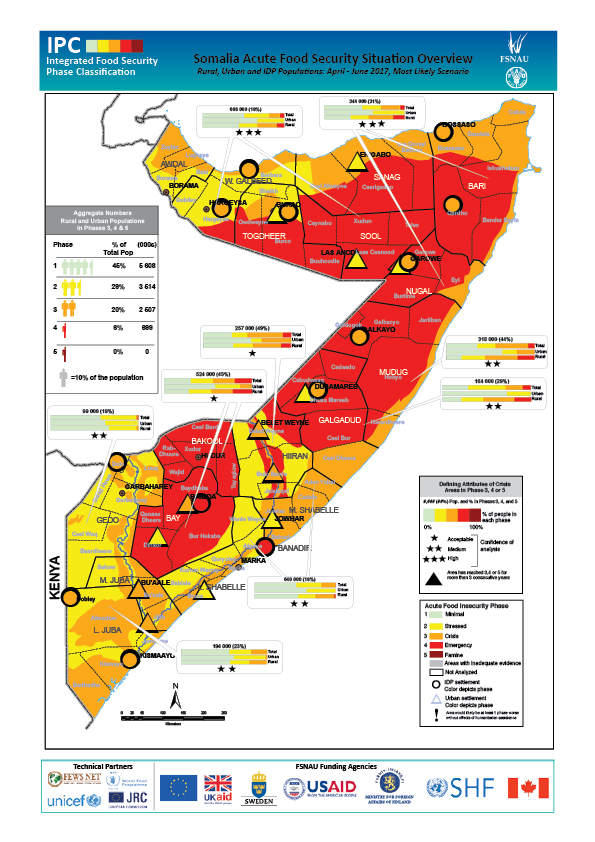
KEY UPDATES
-
January to March Jilaal season. The January to March Jilaal season was drier and hotter than normal and pasture and water resources were extremely limited. April field reports indicated that households in northern and central areas have lost 40-60 percent of their livestock since the Deyr 2016/17 assessment and households in southern regions lost 20-40 percent of their herds, due to distress selling and livestock deaths. Off-season Deyr cereal production was only 357 MT, 93 percent below average, attributed to limited water availability for cultivation and farmers who sold their crops at the vegetative stage for fodder, when the price and demand were high.
-
Gu seasonal progress. April to June Gu rainfall started two weeks later than normal and has been below average in all areas, except in the northeast where rainfall totals have been near average. April rainfall deficits led to crop wilting in rainfed areas and many farmers replanted. Late April/early May rainfall has led to seed germination, but reduced yields are still expected due to early season losses and forecast erratic rainfall. Pasture and water resources have begun to improve with recent rains and it is expected livestock body conditions and value will slowly increase through June.
-
Drought-related displacement. Data from UNHCR indicates that an estimated 437,530 persons have been displaced in the first quarter of 2017 due to drought or drought-related factors. The majority of drought-related displacement has occurred within regions, with people migrating from rural to urban areas.
-
Ongoing humanitarian assistance. Large-scale humanitarian interventions are ongoing. According to the Food Security Cluster, humanitarian partners distributed emergency assistance to approximately 500,000 people in January, over 1,100,000 people in February, and nearly 1,800,000 people in March. Assistance in March reached over 60 percent of the population in Crisis (IPC Phase 3) and Emergency (IPC Phase 4). Data on April distributions is not yet available, but initial reports indicate that the size of the population reached has increased further. Humanitarian assistance has greatly mitigated food consumption gaps among beneficiaries, but several areas remain in Emergency (IPC Phase 4) as a result of significant asset losses. The analysis of the impact of humanitarian assistance will be updated as new information on distributions, as well as information on new population displacement, becomes available.
-
Staple food prices. The prices of local staples remain well above average, although price increases have been somewhat tempered in many markets due to large-scale humanitarian assistance. Consequently, although terms of trade remain significantly below normal, food access is somewhat better than originally projected in February.
-
Post-Jilaal assessment and SMART surveys. In early April, FSNAU conducted integrated nutrition, mortality, and food security surveys in collaboration with the Somalia Ministry of Health and partners. These surveys took place in Bay/Bakool Agropastoral livelihood zone, Northern Inland Pastoral livelihood zone, and among IDPs in Baidoa and Mogadishu. The food security outcome data in all areas point to Crisis (IPC Phase 3) and Emergency (IPC Phase 4) outcomes. As a result of the deterioration, the number of people expected to be in Crisis (IPC Phase 3) and Emergency (IPC Phase 4) between now and June has increased.
-
In all surveyed areas, the prevalence of Global Acute Malnutrition (GAM), as measured by weight-for-height z-score, was at Critical levels (GAM 15-30%), indicative of Emergency (IPC Phase 4). In all areas, results were not statistically different from the GAM prevalence observed during the post-Deyr assessment, except for Northern Inland Pastoral where the GAM and Severe Acute Malnutrition (SAM) increases were statistically significant.
-
The Crude Death Rate (CDR) increased in Bay and among IDPs in Baidoa between December and April. In Bay, the April CDR was 2.43/10,000/day. Among IDPs in Baidoa, the CDR increased to 1.87/10,000/day. Given that the survey was unable to capture most newly-arrived IDPs in Baidoa, it may not have incorporated the most vulnerable households and the actual CDR may be even higher. Disease is likely the key driver of the increase in CDR. For example, in Bay, 80 percent of all deaths were attributed to illness.
-
Data from January to March 2017 on new admissions to treatment and feeding centers for acutely malnourished indicates that there has been a substantial increase in new cases. Over 55,000 new admissions were reported in March, compared to 46,000 in February and 25,000 in January.
-
-
Current food security outcomes.
-
In Bay/Bakool agropastoral areas, Emergency (IPC Phase 4) persists. Based on needs identified in February, humanitarian assistance has reached much of the need in Baidoa town and some surrounding rural areas; however, thousands of households are newly displaced and have lost or sold all assets prior to moving to Baidoa. Most are heavily market dependent and lack income-earning opportunities.
-
Food security outcomes have deteriorated more than previously expected in Hawd Pastoral, Addun Pastoral, Cowpea Belt Agropastoral, and Hiran Agropastoral livelihood zones, due to additional livestock deaths during the prolonged Jilaal season, which has limited household access to milk for consumption and livestock sales to fund cereal purchases. With total livestock losses upwards of 75 percent among poor households, many have experienced significant disruption to their livelihoods. Similar outcomes exist in Northern Inland Pastoral. Large-scale humanitarian assistance has prevented further food security deterioration, but most poor households remain in Emergency (IPC Phase 4) due to heavy livelihood asset losses.
-
-
Risk of Famine. In early 2017, following below-average 2016 Gu rains and failed 2016/17 Deyr rains, FEWS NET and FSNAU warned that Famine (IPC Phase 5) was possible in a worst-case scenario in which the 2017 Gu season performed very poorly, purchasing capacity declined to levels seen in 2011, and humanitarian assistance would be unable to reach populations in need. Large-scale humanitarian assistance in recent months has reduced household food consumption gaps and contributed to reduced staple food prices; however, there remains an elevated risk of Famine (IPC Phase 5) due to the combination of severe food insecurity, high acute malnutrition, high disease burden, and reliance on humanitarian assistance.
-
Projected food security outcomes. Levels of acute food insecurity remain severe and are expected to persist throughout 2017 given the high likelihood of a third consecutive poor harvest in July. Crisis (IPC Phase 3) and Emergency (IPC Phase 4) outcomes are likely in most areas of the country through at least the peak of the lean season in July.
-
Deyr outlook. The October to December Deyr rains are forecast to be average to above average. Despite the favorable rainfall forecast, current food security needs are expected to persist throughout 2017.
Continued large-scale humanitarian assistance, targeting households in Crisis (IPC Phase 3) or higher, is needed throughout 2017, as well as efforts aimed at preventing and treating AWD/cholera.
Download the full report click here
